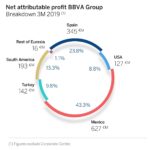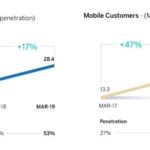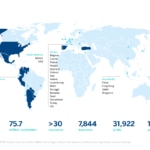BBVA earns €1.16 billion in first quarter
• Transformation: BBVA continued to make progress in its transformation, with a clear impact on growth of its customer base, productivity, efficiency and customer experience. Digital unit sales now account for 57 percent of the total and over half of the customers use digital channels to interact with the bank
• Efficiency: Positive top-line trends in the P&L account, together with an ongoing focus on cost reduction, led to double-digit growth in operating income compared to the first quarter 2018 in constant euros, and an improvement in the efficiency ratio, which dropped 118 basis points since December, to 48.1 percent
• Risk management: The NPL ratio remained at 3.9 percent, while the coverage ratio improved to 74 percent. The cost of risk stood at 1.06 percent
• Capital adequacy: The fully-loaded CET1 capital ratio closed the quarter at 11.35 percent, inching closer to the target of 11.5 to 12 percent, fully absorbing IFRS 16 impact
Profitability: BBVA continued to be a leader in profitability, with ROE standing at 9.9 percent, and ROTE at 11.9 percent, well above the average of its European peers
• Value creation for the shareholder: The tangible book value plus dividends per share rose 11 percent from a year earlier
• Board of Directors: At its meeting today, the Board also approved a series of agreements related to appointments and its committees

Between January and March 2019, the BBVA Group earned €1.16 billion, down 9.8 percent compared to the same period a year earlier and up 16.2 percent from the previous quarter, at current exchange rates. Excluding BBVA Chile’s Q1-18 earnings from the comparison (the unit was sold in July 2018), the result was 7.7 percent lower (-6.0 percent in constant euros) versus a year ago.
“We started the year with positive dynamics. Operating income grew above 10 percent, thanks to strong core revenue generation and a significant improvement in efficiency. Also, we continued to reap the benefits of our digital transformation in terms of customer growth and engagement,” said BBVA CEO Onur Genç.
To ensure a better understanding of the yoy comparison, the figures detailed below exclude BBVA Chile. With this homogenous perimeter, net interest income grew 5.8 percent yoy in the first three months of the year (+9.5 percent in constant terms), to €4.42 billion. Fees and commissions remained virtually flat yoy (-0.6 percent at current exchange rates), although they increased 2.6 percent excluding exchange rate effects. Both lines combined, considered the recurring revenues in the banking business, grew 8.0 percent yoy stripping out currency fluctuations. NTI results were up 8.7 percent (+13.5 percent in constant euros). Thus, the gross income improved by 3.3 percent yoy, or 7.0 percent in constant terms, to €6.07 billion.

As for operating expenses, cost discipline efforts yielded positive results again across all geographies in the quarter. At 0.7 percent (+3.7 percent in constant terms) the line’s growth was well below that of recurring revenues and the Group’s average inflation. Positive top-line trends in the P&L account, combined with the ongoing focus on cost reduction, led to double digit growth in operating income (+10.2 percent at constant exchange rates, to €3.15 billion) and an improvement in the bank’s efficiency ratio, which reached 48.1 percent (118 basis points less than in 2018), well below the average of its comparable European peers (65.4 percent).
Net attributable profit for BBVA Group was €1.16 billion in the first quarter, down 7.7 percent yoy (-6.0 percent excluding currency trends), as a result of increased impairments in the United States and Turkey, compared to the same period a year earlier – although, in the case of Turkey, these impairments were significantly lower than in the preceding quarter – as well as the provisions due to the worsening conditions in the macro environment in most geographies.
In terms of value creation for the shareholder, the ROE and ROTE ratios stood again at favorable levels (9.9 percent and 11.9 percent in the quarter, respectively), keeping BBVA at the top of the European financial industry in terms of profitability. Also, tangible book value per share – the indicator that represents the book value of the company for each share owned by shareholders – plus the dividends paid out against 2018 earnings increased to €6.20 per share, an 11 percent growth yoy.
Asset quality metrics remained stable. In March the NPL ratio stood at the same levels of December (3.9 percent) and the coverage ratio improved to 74 percent, from 73 percent a quarter earlier. The cost of risk stood at 1.06 percent, an increase from Q1-18, which was exceptionally low, driven by provision releases and a more favorable macro environment.
The fully-loaded CET1 capital ratio showed significant resilience. After absorbing the full impact of the implementation of IFRS 16, following its entry into force earlier this year, the fully-loaded CET1 ratio stood at 11.35 percent in March. This result inches closer to the bank’s target of 11.5 to 12 percent. Also, BBVA maintained its shareholder remuneration policy, with a 35 to 40 percent cash payout. The bank’s leverage ratio (6.4 percent) was once again the highest among European peers.
Regarding the balance sheet and lending activity, customer loans grew 3.0 percent (at current exchange rates) over the past 12 months, to €393.32 billion. As for deposits, trends were also positive, driving the line to grow at 5.1 percent to €378.53 billion.
Transformation
BBVA continued to make progress in its transformation, with a clear impact on growth of its customer base, productivity, efficiency and customer experience. With data as of the end of March, over half of customers (53 percent) were using digital channels to interact with the bank. Mobile customers accounted for 45 percent of the total, and are expected to surpass the 50-percent threshold, in line with the target set for the year. Total unit sales through digital channels accounted for 57 percent of the total, more than double their contribution from two years ago.

The main highlights of each business area are detailed below.
Following the transfer of the real estate business to Cerberus, the Non-Core Real Estate area has been integrated into the banking activity of Spain and the area will now report as Spain. Good news in activity trends: lending grew 1.8 percent yoy, with notable growth in consumer lending and credit cards, up 19.7 percent, and medium-sized enterprises, up 7.0 percent. Customer resources grew 4.3 percent, driven by demand deposits and investment funds. Spain earned €345 million in the first quarter, down 14.7 percent yoy, but 11.7 percent higher compared to the previous quarter. Asset quality continued to improve thanks to lower levels of NPLs, with an NPL ratio that dropped from 5.10 percent in December to 4.95 percent in March. Coverage ratio rose to 58 percent.
In the United States, lending grew 6.6 percent yoy, while customer deposits grew 1.5 percent yoy. Net interest income benefited from these higher volumes, especially in the most profitable business segments, and the interest rate hikes, growing 8.4 percent in the quarter in yoy terms excluding currency fluctuations (+17.4 percent in current euros). Efficiency improved thanks to the moderation in expenses, which grew less than gross income. The area earned €127 million in the first three months, down 39.8 percent from a year ago (-34.8 percent considering currency impacts), due to higher impairments in some portfolios and the negative macro economic impact from IFRS 9. In Q1-18, the area benefited from the release of provisions and the positive macro economic impact from the same IFRS 9. The NPL ratio stood at 1.4 percent, while the coverage ratio was 85 percent.
In Mexico, where BBVA is the market leader, lending grew 8.6 percent and customer deposits increased 6.5 percent. This dynamism also reflected in the net interest income, which grew 7.8 percent in constant terms (+13.9 percent including FX effect). The area’s net attributable profit stood at €627 million (+4.7 percent in constant euros, +10.6 percent in current euros yoy), thanks to the positive trend in recurring revenues. Risk indicators remained solid: the NPL ratio declined to 2.0 percent from 2.1 percent in December, and coverage ratio stood at 159 percent.
In Turkey, the Turkish-lira loan portfolios grew 7.0 percent yoy, while loans in U.S. dollars declined almost 20 percent in the same period. Deposits remained as the main source of funding for the balance sheet. Customer deposits in dollars fell 8.2 percent yoy, while deposits in Turkish liras increased by 12 percent, in line with the trend from last year. Turkey earned €142 million, down 7.7 percent yoy (-29.2 percent at current exchange rates), but 54.8 percent more than in the last quarter of 2018, mainly due to a significant reduction in impairments on financial assets and provisions.
In South America, activity continued to grow at a good pace. Excluding BBVA Chile in the comparison, lending increased 7.5 percent yoy, with a notable performance in Argentina (+38.0 percent), followed by Peru (+6.5 percent) and Colombia (+2.1 percent). Customer deposits grew 12.2 percent, with solid figures in Argentina (+61.6 percent), Peru (+12.6 percent) and Colombia (+4.3 percent). The area’s net attributable profit stood at €193 million, up 86.5 percent from a year earlier excluding currency effects, or 50.9 percent more including FX effect in the comparison. The results were supported both by positive trends in recurring revenues and the positive impact of the sale of approximately half the stake in Prisma in Argentina (€50 million after taxes.) The area’s NPL ratio stood at 4.4 percent, with a coverage of 96 percent.
Board of Directors
The Board of Directors also approved a series of changes:
• José Miguel Andrés Torrecillas has been appointed deputy chairman. As his replacement, Juan Pi Llorens has been appointed lead independent director.
• Redistribution of functions amongst certain committees, and subsequent changes to their denomination. Compliance-related matters will now be addressed at the newly named Risk and Compliance Committee, while corporate governance topics will be added to the newly named Appointments and Corporate Governance Committee.
• Certain changes in the composition of the committees.

About BBVA

BBVA is a customer-centric global financial services group founded in 1857. The Group has a strong leadership position in the Spanish market, is the largest financial institution in Mexico, it has leading franchises in South America and the Sunbelt Region of the United States. It is also the leading shareholder in Turkey’s Garanti BBVA. Its purpose is to bring the age of opportunities to everyone, based on our customers’ real needs: provide the best solutions, helping them make the best financial decisions, through an easy and convenient experience. The institution rests in solid values: Customer comes first, we think big and we are one team. Its responsible banking model aspires to achieve a more inclusive and sustainable society.